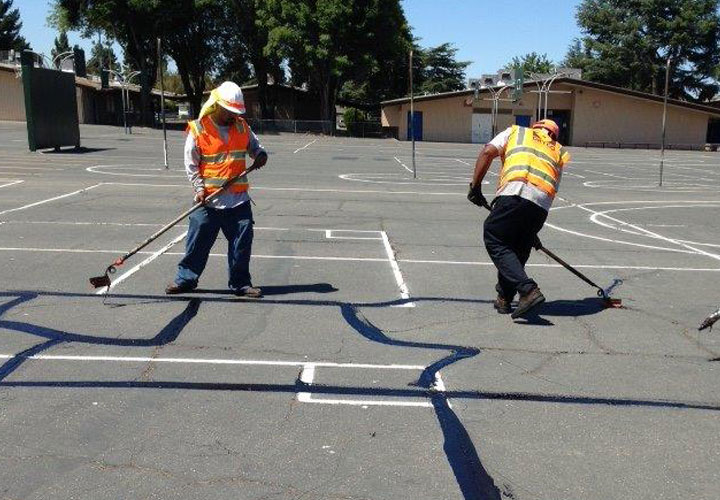Effective Asphalt Repair: Cold Mix Sealing Techniques Unveiled
Cold Mix Asphalt Vs. Hot Mix Asphalt: Which Is Right for You?

Composition Differences
Cold mix and hot mix asphalts vary considerably in their composition, with unique qualities that impact their performance and applications. Cold mix asphalt is created by emulsifying the asphalt binder with water and an emulsifying representative prior to mixing it with accumulation. This technique permits for the asphalt to be workable at reduced temperature levels, making it optimal for short-lived repairs and for use in cooler weather. Hot mix asphalt, on the other hand, is made at high temperatures, normally in between 300-350 ° F, which helps to attain far better compaction and a much more sturdy last item. The warm mix asphalt production process includes warming the aggregate and asphalt binder individually prior to combining them at the asphalt plant.
In addition, cold mix asphalt tends to be much less dense and extra flexible than warm mix asphalt. This versatility makes it better fit for areas with greater degrees of motion, such as driveways or roadways with rush hour. In comparison, hot mix asphalt is known for its high toughness and resistance to rutting and fracturing, making it a favored selection for highways and high-traffic roadways where longevity is critical.
Installation Refine Differences
The procedure of installing chilly mix and hot mix asphalt exhibits notable variations in their needs and procedures. In comparison, hot mix asphalt requires a much more sophisticated installment process. Due to the home heating needs, hot mix asphalt installations are normally lugged out by specialists with customized equipment, guaranteeing a much more structurally sound and permanent outcome.
Durability and Longevity Variables
When taking into consideration asphalt alternatives, longevity and long life are crucial elements to assess for enduring pavement performance. Hot mix asphalt (HMA) is known for its outstanding toughness and longevity. The high temperature levels throughout the mixing and laying process enable far better compaction, leading to a denser and more powerful pavement framework. This causes HMA being extra resistant to heavy website traffic loads, rough weather, and the impacts old contrasted to cool mix asphalt (CMA)
In regards to longevity, HMA usually outperforms CMA due to its exceptional strength and resistance residential or commercial properties. HMA pavements have a longer solution life, calling for less constant repair services and maintenance, which can equate to set you back savings over time. Furthermore, HMA sidewalks are extra conveniently personalized to fulfill details job requirements, better improving their durability.
Cost Considerations
Considering the monetary effects is an important facet when evaluating the option in between hot mix asphalt (HMA) and cool mix asphalt (CMA) for sidewalk tasks. While the first cost of hot mix asphalt is commonly greater than that of cool mix asphalt, HMA frequently offers a more economical option in the future as a result of its superior toughness and long life. HMA is understood for its capability to stand up to hefty web traffic tons and rough climate condition, decreasing the demand for regular repairs and maintenance. On the various other hand, cool mix asphalt is more affordable in advance yet may require more frequent patching and resurfacing, leading to greater maintenance costs with time.
Along with product expenses, it's vital to take into consideration the expenses related to installment and maintenance when comparing HMA and CMA. HMA usually needs specific tools and experienced labor for proper installment, which can affect total task costs. On the other hand, CMA is simpler to collaborate with and can typically be applied making use of easier techniques, potentially decreasing setup costs. Eventually, the decision between HMA and CMA need to think about not just the first price yet likewise the lasting economic effects to identify the most cost-efficient choice for the details sidewalk project.
Environmental Impact Comparison
Contrast of the ecological impacts in between warm mix asphalt (HMA) and chilly mix asphalt (CMA) exposes distinct differences in sustainability techniques. HMA manufacturing needs high temperature levels, bring about increased energy intake and greenhouse gas exhausts. The procedure also releases unpredictable organic compounds (VOCs) and unsafe air contaminants (HAPs) into the atmosphere. In contrast, CMA is produced and applied at lower temperatures, minimizing power usage and discharges considerably. The reduced manufacturing temperatures of CMA lead to reduced fuel usage and lower degrees of carbon dioxide exhausts, making it a more eco-friendly alternative.
Furthermore, the usage of CMA usually entails recycling existing asphalt sidewalk, promoting source conservation and reducing the amount of waste sent to land fills. By opting for CMA over HMA, roadway building tasks can add favorably to environmental preservation efforts.
Final Thought
Finally, the selection between cool mix asphalt (CMA) and hot mix asphalt (HMA) depends on numerous variables such as structure, setup procedure, durability, durability, price, and environmental effect. asphalt repair. While CMA provides a quick and economical service for small repair services, HMA guarantees remarkable resilience and durability for hefty traffic areas. Think about asphalt patch repair these factors thoroughly to figure out which kind of asphalt is the ideal option for your paving requires

Thinking about the financial effects is an essential aspect when examining the option between hot mix asphalt (HMA) and cool mix asphalt (CMA) for pavement jobs. While the first expense of warm mix asphalt is usually higher than that of cool mix asphalt, HMA usually offers a more economical option in the long run due to its superior resilience and longevity. angle parking.Comparison of the ecological influences in between warm mix asphalt (HMA) and chilly mix asphalt (CMA) discloses unique distinctions in sustainability methods.In verdict, the choice between chilly mix asphalt (CMA) and hot mix asphalt (HMA) depends on various elements such as composition, installment procedure, durability, long life, price, and environmental influence